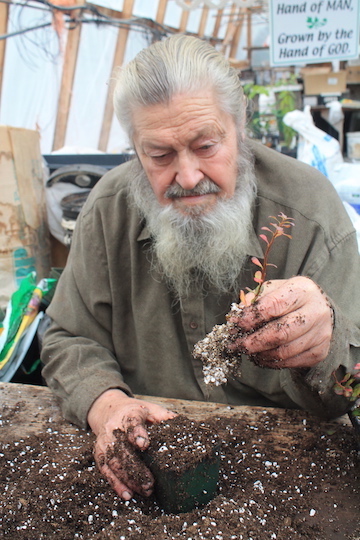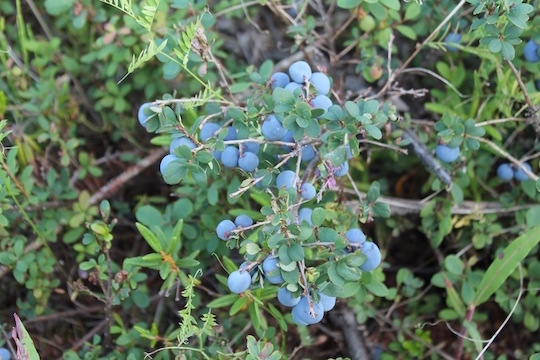Project Overview
Annual Reports
Commodities
- Fruits: berries (other), berries (blueberries)
- Additional Plants: native plants
Practices
- Education and Training: demonstration, on-farm/ranch research
- Production Systems: general crop production
Summary:
 Planting rooted blueberry cuttings in the fall[/caption]
[caption id="attachment_364455" align="alignnone" width="360"]
Planting rooted blueberry cuttings in the fall[/caption]
[caption id="attachment_364455" align="alignnone" width="360"] Rooting blueberry cuttings in misting chamber[/caption]
[caption id="attachment_364456" align="alignnone" width="540"]
Rooting blueberry cuttings in misting chamber[/caption]
[caption id="attachment_364456" align="alignnone" width="540"] Bog Blueberries ready to pick[/caption]
Bog Blueberries ready to pick[/caption]
Wild blueberries, Vaccinium uliginosum, are highly desirable in Interior Alaska. They are found throughout the circumpolar north, but the plants are short and harvesting is slow and laborious. Nobody is growing these berries commercially, and harvesting equipment has not been identified that will work well on this species. There is a lot of variability among blueberry plants in the wild. Some of these differences may be due to genetics, and some may be due to site conditions. Our goal was to identify the best blueberry plants in terms of yield potential and bush structure adaptable to mechanical harvesting, and to reestablish those plants on uniform sites on our farms where they could be selected and propagated for commercial production. The challenges include: identifying superior plants, propagating the plants, developing cultural practices for growing the plants, selecting or developing a mechanical harvester for the berries, and developing a market for the berries. This project focused on selecting superior plants from the wild, propagating those plants, and moving those plants to uniform sites on farms.
At the beginning of this project, we knew where many of the best berry picking areas were in Interior Alaska. We started by collecting berries, extracting their seed, growing seedlings, and evaluating for superior qualities. This is a long process and the desired characteristic of the mother plant might not be expressed in the seedlings. Thus, it was difficult to determine if the desired trait was actually genetic or site related. Next, we learned how we could propagate the blueberry plants by softwood cuttings. This process had several advantages over propagation by seeds. The softwood cuttings are genetically identical to the mother plant and collection time for softwood cuttings is ideal because they can be collected at the same time one is picking berries and surveying a lot of plants. We rooted the cuttings under a misting system in a greenhouse, transplanted the cuttings into individual pots, and overwintered the plants. Then we lost a large percentage of them the following summer. We hadn’t considered that our irrigation water might be so hard that minerals in the irrigation water would overpower the soil acidity in our small pots and the small plants wouldn’t be able to take up the needed micronutrients from the neutralized soil. Also, blueberries plants rely on mychorrhizal associations with fungi to take up nutrients. Even though we had inoculated the young plants with mycorrhizae, it may not have had adequate time to colonize the new roots, so a combination of hard water and possibly the lack of established mycorrhizae stressed the plants and most of them died. We were in the process of collecting acidic rainwater, and experimenting with acidifying our well water when we stumbled onto an easier method of propagation, simple plant division. The wild blueberries propagate mainly by layering, and most of the roots are in the moss layer above the mineral soil. By going around the perimeter of a wild blueberry plant and pulling up on the branches, one can fairly easily expose a portion of a branch with roots on it. These rooted branches can be pruned so they don’t have too much top growth for the surviving root system, and the plant division can be potted up and treated just like the rooted cuttings. Over the summers of 2013 and 2014, we identified about 50 superior mother plants in the wild and by plant division have approximately 500 potted plants ready to plant on our farms during the summer of 2016.
Introduction
The bog blueberry, Vaccinium uliginosum, grows across millions of acres of the circumpolar north. It has been a staple food for indigenous people throughout history. Most northern people prefer the flavor of the bog blueberry to domestic blueberries, but commercial varieties of V. uliginosum have never been developed in North America. Most of Alaska is too far north for the domesticated North American high bush, half high, and low bush blueberries (V. corymbosum, V. angustifolium, and hybrids) to survive. Also, recent scientific studies have shown that Alaskan bog blueberries contain concentrations of antioxidants approximately 10 times higher than domestic blueberries. The bog blueberry remains a choice berry for wild berry pickers in Alaska and the demand far exceeds the supply. However, the plants are short, and the labor of picking the berries makes them too expensive to market commercially. When picking wild blueberries in Interior Alaska, we find that there is a tremendous variability in berry size, shape, flavor, bush height, and other characteristics. The plants are all in the species of Vaccinium uliginosum. We don’t know how much of this variability is due to genetic differences, and how much is due to the age of the plant, microclimate or other site conditions. Our goal has been to collect wild blueberry plants that exhibit desirable characteristics and move them to our farms where they can be grown under uniform conditions so we can determine if those desirable characteristics are true differences, or just responses to favorable site conditions. This project was an effort to collect superior bog blueberry plants and move them to agricultural fields where they could be evaluated for domestication. It also provided an opportunity to involve the public and provided information on bog blueberry selection, propagation and production to potential growers.
Project objectives:
Obj. 1. Select 50 superior bog blueberry plants from diverse locations in Interior Alaska, collect 30 cuttings from each plant, and record the site characteristics and plant characteristics that make each plant desirable for propagation.
Obj. 2. Root and care for the cuttings; i.e. root 1500 cuttings in a misting chamber, plant 1000 of the best rooted cuttings (20 from each mother plant) in 3 1/2 inch pots, allow them to become dormant, overwinter them, start the plants off in a greenhouse the next spring, and move them outside in mid summer to harden them off.
Obj. 3. Plant 10 plants from each mother plant (500 for each farm) in rows in agricultural fields where they can be evaluated for desirable characteristics for domestication and mechanical harvesting.
Obj. 4. Share information about bog blueberries, their selection, propagation, and management with other berry growers by: a) giving a presentation to the Alaska Pioneer Fruit Growers Association in Anchorage; b) giving a presentation at the SARE Conference in Fairbanks; and c) holding an informal field day in cooperation with the Cooperative Extension Service at Papa’s Greenhouse.